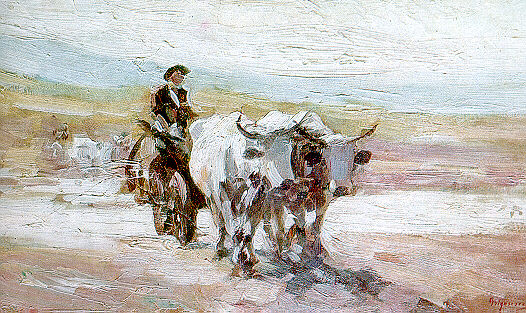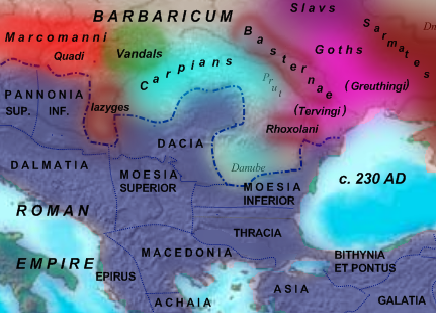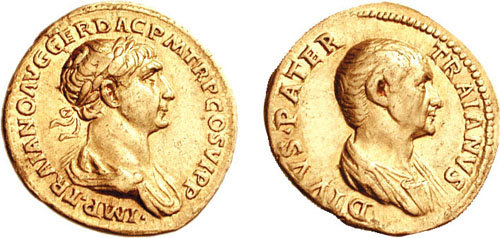|
Art Of Romania
Romanian art consists of the visual and plastic arts (including Romanian architecture, woodwork, textiles, and ceramics) originating from the geographical area of Romania. The production of art in Romania is as old as the Paleolithic, an example being a cave painting from the Cuciulat Cave (Sălaj County). During the Neolithic, multiple cultures lived on the modern territory of Romania. Their material culture included pottery and abstract clay statuettes decorated with geometric patterns. These may give hints on the way these civilizations used to dress and maybe tattoo. A good examples of this is the Thinker of Hamangia, a clay figurine produced by the Hamangia culture. Important cultures of the Neolithic era include Starčevo–Körös–Criș, Boian, Gumelnița–Karanovo, and other ones, the most famous and at the same time the most evolved among them in art being the Cucuteni–Trypillia culture. During Antiquity, the Geto-Dacians produced art and built multiple ci ... [...More Info...] [...Related Items...] OR: [Wikipedia] [Google] [Baidu] |
Dacians
The Dacians (; ; ) were the ancient Indo-European inhabitants of the cultural region of Dacia, located in the area near the Carpathian Mountains and west of the Black Sea. They are often considered a subgroup of the Thracians. This area includes mainly the present-day countries of Romania and Moldova, as well as parts of Ukraine, Moravian Banovina, Eastern Serbia, Northern Bulgaria, Slovakia, Hungary and Southern Poland. The Dacians and the related Getae spoke the Dacian language, which has a debated relationship with the neighbouring Thracian language and may be a subgroup of it. Dacians were somewhat culturally influenced by the neighbouring Scythians and by the Celtic invasion of the Balkans, Celtic invaders of the 4th century BC. Name and etymology Name The Dacians were known as ''Geta'' (plural ''Getae'') in Ancient Greek writings, and as ''Dacus'' (plural ''Daci'') or ''Getae'' in Roman Empire, Roman documents, but also as ''Dagae'' and ''Gaete'' as depicted on ... [...More Info...] [...Related Items...] OR: [Wikipedia] [Google] [Baidu] |
Eastern Orthodox Church
The Eastern Orthodox Church, officially the Orthodox Catholic Church, and also called the Greek Orthodox Church or simply the Orthodox Church, is List of Christian denominations by number of members, one of the three major doctrinal and jurisdictional groups of Christianity, with approximately 230 million baptised members. It operates as a Communion (Christian), communion of autocephalous churches, each governed by its Bishop (Orthodox Church), bishops via local Holy Synod, synods. The church has no central doctrinal or governmental authority analogous to the pope of the Catholic Church. Nevertheless, the Ecumenical Patriarch of Constantinople is recognised by them as ''primus inter pares'' (), a title held by the patriarch of Rome prior to 1054. As one of the oldest surviving religious institutions in the world, the Eastern Orthodox Church has played an especially prominent role in the history and culture of Eastern Europe, Eastern and Southeastern Europe. Since 2018, the ... [...More Info...] [...Related Items...] OR: [Wikipedia] [Google] [Baidu] |
Origin Of The Romanians
Several theories, in great extent mutually exclusive, address the issue of the origin of the Romanians. The Romanian language descends from the Vulgar Latin dialects spoken in the Roman provinces north of the "Jireček Line" (a proposed notional line separating the predominantly Latin language, Latin-speaking territories from the Koine Greek, Greek-speaking lands in Southeastern Europe) in Late Antiquity. The theory of Daco-Roman continuity argues that the Romanians are mainly descended from the Daco-Romans, a people developing through the cohabitation of the native Dacians and the Roman colonists in the province of Dacia Traiana (primarily in present-day Romania) north of the river Danube. The competing immigrationist theory states that the Romanians' ethnogenesis commenced in the provinces south of the river with Romanized local populations (known as Vlachs in the Middle Ages) spreading through mountain refuges, both south to Greece and north through the Carpathian Mountains. ... [...More Info...] [...Related Items...] OR: [Wikipedia] [Google] [Baidu] |
Romanization (cultural)
Romanization or Latinization (Romanisation or Latinisation), in the historical and cultural meanings of both terms, indicate different historical processes, such as acculturation, integration and assimilation of newly incorporated and peripheral populations by the Roman Republic and the later Roman Empire. The terms were used in ancient Roman historiography and traditional Italian historiography until the Fascist period, when the various processes were called the " civilizing of barbarians". Characteristics Acculturation proceeded from the top down, with the upper classes adopting Roman culture first and the old ways lingering longest among peasants in outlying countryside and rural areas. Hostages played an important part in this process, as elite children, from Mauretania to Gaul, were taken to be raised and educated in Rome. Ancient Roman historiography and traditional Italian historiography confidently identified the different processes involved with a "civilization of b ... [...More Info...] [...Related Items...] OR: [Wikipedia] [Google] [Baidu] |
Roman Empire
The Roman Empire ruled the Mediterranean and much of Europe, Western Asia and North Africa. The Roman people, Romans conquered most of this during the Roman Republic, Republic, and it was ruled by emperors following Octavian's assumption of effective sole rule in 27 BC. The Western Roman Empire, western empire collapsed in 476 AD, but the Byzantine Empire, eastern empire lasted until the fall of Constantinople in 1453. By 100 BC, the city of Rome had expanded its rule from the Italian peninsula to most of the Mediterranean Sea, Mediterranean and beyond. However, it was severely destabilised by List of Roman civil wars and revolts, civil wars and political conflicts, which culminated in the Wars of Augustus, victory of Octavian over Mark Antony and Cleopatra at the Battle of Actium in 31 BC, and the subsequent conquest of the Ptolemaic Kingdom in Egypt. In 27 BC, the Roman Senate granted Octavian overarching military power () and the new title of ''Augustus (title), Augustus'' ... [...More Info...] [...Related Items...] OR: [Wikipedia] [Google] [Baidu] |
Dacia
Dacia (, ; ) was the land inhabited by the Dacians, its core in Transylvania, stretching to the Danube in the south, the Black Sea in the east, and the Tisza in the west. The Carpathian Mountains were located in the middle of Dacia. It thus roughly corresponds to present-day Romania, as well as parts of Moldova, Bulgaria, Serbia, Hungary, Slovakia, Czech Republic, Poland and Ukraine. A Dacian kingdom that united the Dacians and the Getae was formed under the rule of Burebista in 82 BC and lasted until the Roman conquest in AD 106. As a result of the Trajan's Dacian Wars, wars with the Roman Empire, after the conquest of Dacia, the population was dispersed, and the capital city, Sarmizegetusa Regia, was destroyed by the Romans. However, the Romans built a settlement bearing the same name, Ulpia Traiana Sarmizegetusa, Ulpia Traiana Sarmizegetuza, 40 km away, to serve as the capital of the newly established Roman Dacia, Roman province of Dacia. A group of "Free Dacians" may ... [...More Info...] [...Related Items...] OR: [Wikipedia] [Google] [Baidu] |
Trajan
Trajan ( ; born Marcus Ulpius Traianus, 18 September 53) was a Roman emperor from AD 98 to 117, remembered as the second of the Five Good Emperors of the Nerva–Antonine dynasty. He was a philanthropic ruler and a successful soldier-emperor who presided over one of the greatest military expansions in Roman history, during which, by the time of his death, the Roman Empire reached its maximum territorial extent. He was given the title of ('the best') by the Roman Senate. Trajan was born in the of Italica in the present-day Andalusian province of province of Seville, Seville in southern Spain, an Italic peoples, Italic settlement in Hispania Baetica; his came from the town of Todi, Tuder in the Regio VI Umbria, Umbria region of central Italy. His namesake father, Marcus Ulpius Traianus (father of Trajan), Marcus Ulpius Traianus, was a general and distinguished senator. Trajan rose to prominence during the reign of Domitian; in AD 89, serving as a in , he supported t ... [...More Info...] [...Related Items...] OR: [Wikipedia] [Google] [Baidu] |
Trajan's Dacian Wars
Trajan's Dacian Wars (101–102, 105–106) were two military campaigns fought between the Roman Empire and Dacia during Roman Emperor, Emperor Trajan's rule. The conflicts were triggered by the constant Dacian threat on the Danube, Danubian Roman Province, province of Moesia and also by the increasing need for resources of the economy of the Empire. Background Throughout the 1st century, Roman policy dictated that threats from neighbouring nations and provinces were to be contained promptly. Dacia had been on the Roman agenda since before the days of Caesar when the Dacians defeated a Roman army at the Battle of Histria. Domitian's Dacian War had re-established peace with Dacia in 89 AD. However, the Dacian king Decebalus used the Roman annual subsidy of 8 million sestercesJones (1992), p150. and craftsmen in trades devoted to both peace and war, and war machines intended to defend the empire's borders to fortify his own defences instead. Despite some co-operation on the dip ... [...More Info...] [...Related Items...] OR: [Wikipedia] [Google] [Baidu] |
Mangalia
Mangalia (, ), ancient Callatis (; other historical names: Pangalia, Panglicara, Tomisovara), is a city and a port on the coast of the Black Sea in the south-east of Constanța County, Northern Dobruja, Romania. The municipality of Mangalia also administers several summertime seaside resorts: Cap Aurora, Jupiter, Neptun, Olimp, Saturn, and Venus. History The Greek colony of Callatis was founded in the 6th century BC by the city of Heraclea Pontica. Like the other Greek cities on the coast nearby, it became a Greek city-state with its own ''chora'' (territory) which included the fortified settlement of Albesti 15km distant. Its first silver coinage was minted around 350 BC. The Macedonians invaded the area from 339 BC against which Callatis and the nearby Greek cities revolted leading to the siege of the city in 313-311 by Lysimachus and its reoccupation. In 72 BC, Callatis was conquered by the Roman general Lucullus and was assigned to the Roman province of Moesia Infe ... [...More Info...] [...Related Items...] OR: [Wikipedia] [Google] [Baidu] |







